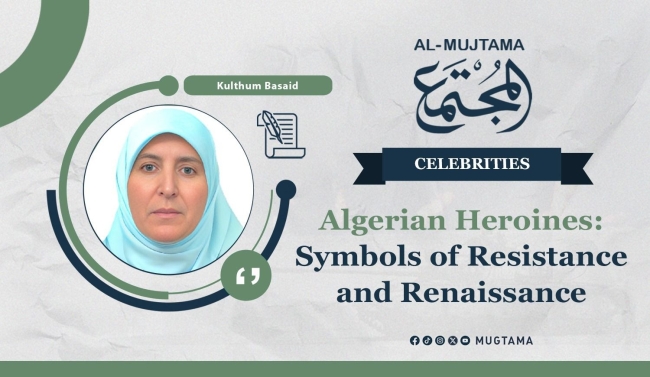Algerian Heroines: Symbols of Resistance and Renaissance
The greatest gift you can give a person—after guiding them to the right path—is to free them from anything that binds their freedom, whether it be slavery, imprisonment, or occupation and colonization.
A person whose freedom is restricted in any form has their will taken away to varying degrees, and others control them to varying extents as well.
What applies to individuals also applies fully to nations. No nation can achieve renaissance and progress while its freedom is restricted, whether through direct occupation or dependency on a state or a group of states.
Renaissance will not be complete or comprehensive if it occurs under occupation or dependency; rather, it will be incomplete, hindered by obstacles and barriers, or even entirely crushed.
Therefore, there can be no renaissance without the complete liberation of peoples from any form of occupation or dependency.
The path to renaissance goes through freedom, and Algeria, like other countries and nations, could not tread the path to renaissance except through the bridge of freedom.
Algeria has sacrificed much blood in its struggle for liberation from the brutal French colonization and before that, the nearly three-century-long Spanish occupation of Oran in western Algeria.
Algeria suffered partial and total occupation for nearly five centuries, leaving negative impacts on its politics, education, economy, and health, among other areas.
Everyone stood up against this occupation: men and women, scholars and students, the educated and the illiterate, and so forth.
Here, we want to highlight the role of women; Algerian women did not hesitate to stand against the aggression. Some even led the resistance against the French colonizer.
One prominent figure is Lalla (1) Fatma N'Soumer (1830–1863), who inflicted significant losses on the French, delivering them major defeats. The uprising she led against the colonizer remains one of the most significant aspects of the resistance in Algeria due to her courage and nobility.
The French referred to her at the time as The Alegerian Jeanne d'Arc (after the Djurdjura Mountains in the region), a comparison she rejected, preferring to be known as Khawla of Djurdjura after the companion Khawla bint Al-Azwar. (2)
Many other women have also shone in the national cause since the French occupation, such as the resistance leader Lalla Zineb Al-Qassimi, and the martyrs Hassiba Ben Bouali, Malika Gaïd, and Fadhila Saadane, as well as the famed trio of freedom fighters Jamila Bouhired, Jamila Bouazza, and Jamila Boupacha. (3)
The participation in jihad and resistance was not an individual effort for some women but extended beyond that, becoming a phenomenon worth studying. Researcher Imran Jamila counted 10,949 female fighters in the ranks of the Algerian revolution, including 9,194 civilian fighters and 1,755 military fighters in the Liberation Army.
According to statistics from the National Center for Studies and Research on the National Movement and the November 1, 1954 Revolution, concerning the age of female mujahidat and freedom fighters, 15% were under 20 years old, and 85% were under 30 years old, making young women the primary demographic.
Rural women made up about 70%, while urban women accounted for around 20%.
Statistics on imprisoned and martyred women show that 1,343 female fighters were imprisoned, and 948 were killed. (4)
This participation even astonished the enemy. General Massu recorded in his memoirs that Algerian women carried bombs to place in strategic locations, forming a real network thanks to their devices and feigned innocence, enabling them to infiltrate desired circles without arousing suspicion. (5)
Women played a significant role in treating wounded mujahideen. Some combined nursing with smuggling weapons to fedayeen (guerrillas) for their missions, like the martyr Zubida Ould Kabbalia, recorded in history as the first university student to fall in the field of honor. (6)
Others played significant roles in organizing demonstrations, educating mujahideen, and relaying news, such as the martyr Malika Gaïd. (7)
Jihad has its price: martyrdom, injury, or imprisonment. When captured, the enemy inflicted the harshest torture and punishment to extract information. Given the despicable nature of colonial soldiers, they did not hesitate to rape the noble, chaste women. Frenchman Henri Poulet admitted witnessing hundreds of rape cases in just ten months in 1961, mostly occurring in interrogation and torture centers in Algeria. He recounted in his book “La Villa Sesini” that raping Algerian women during military campaigns occurred at a rate of nine out of ten. (8)
After gaining independence, dozens of women who participated in the revolution continued to work in public life, such as Z'hor Ounissi, a politician and writer who held various ministerial positions, co-founded the National Union of Algerian Women, managed the magazine “Algerian Woman,” and served as a member of parliament. Another example is Nafissa Hamoud, a doctor and former fighter in the National Liberation Army, who held ministerial positions, chaired the National Union of Algerian Women, and worked in the health sector. (9)
These are examples of the symbols of jihad, resistance, and liberation from Algerian women who paved the way to freedom and renaissance alongside their male counterparts.
A nation that has resisted and fought for five centuries without surrendering can tread the path of renaissance, progress, and advancement.
If we have not yet achieved the renaissance worthy of this nation, sixty years after gaining independence, it does not lead us to despair and frustration. What was destroyed and erased in five centuries cannot, by any means, be rebuilt in fifty years.
Those who have shed blood do not hesitate to sweat for their nation's renaissance and elevation. But for the martyrs sake, Algeria, requires us not to forget the efforts of our predecessors, to walk in their footsteps, follow their path, and continue their journey.
-------------------------------------------------------------
- Means honorable woman.
- https://www.aljazeera.net/encyclopedia/2014/11/30/%D9%81%D8%A7%D8%B7%D9%85%D8%A9-%D9%86%D8%B3%D9%88%D9%85%D8%B1
- https://www.aljazeera.net/women/2022/3/7/%D8%AD%D9%85%D9%84%D9%86-%D8%A7%D9%84%D8%B3%D9%84%D8%A7%D8%AD-%D9%88%D9%81%D8%AC%D8%B1%D9%86-%D8%A7%D9%84%D9%82%D9%86%D8%A7%D8%A8%D9%84-%D9%88%D8%AA%D8%B9%D8%B1%D8%B6%D9%86
- Ibid.
- Ibid.
- http://www.ech-chaab.com/ar/%D8%B5%D9%81%D8%AD%D8%A7%D8%AA-%D8%AE%D8%A7%D8%B5%D8%A9/%D8%A7%D9%84%D8%AA%D8%A7%D8%B1%D9%8A%D8%AE/item/144793-%D8%B4%D9%87%D9%8A%D8%AF%D8%A7%D8%AA-%D8%AE%D9%84%D9%91%D9%80%D9%80%D8%AF%D9%86-%D8%A3%D8%B3%D9%85%D8%A7%D8%A1%D9%87%D9%86-%D9%81%D9%8A-%D8%B3%D8%AC%D9%80%D9%84-%D8%A7%D9%84%D8%AA%D8%B6%D8%AD%D9%8A%D9%80%D8%A7%D8%AA.html
- Ibid.
- https://www.aljazeera.net/women/2022/3/7/%D8%AD%D9%85%D9%84%D9%86-%D8%A7%D9%84%D8%B3%D9%84%D8%A7%D8%AD-%D9%88%D9%81%D8%AC%D8%B1%D9%86-%D8%A7%D9%84%D9%82%D9%86%D8%A7%D8%A8%D9%84-%D9%88%D8%AA%D8%B9%D8%B1%D8%B6%D9%86
- https://raseef22.net/article/1088481-%D8%A3%D8%AE%D9%88%D8%A7%D8%AA%D9%86%D8%A7-%D8%A7%D9%84%D9%85%D9%82%D8%A7%D8%AA%D9%84%D8%A7%D8%AA-%D9%85%D8%AC%D8%A7%D9%87%D8%AF%D8%A7%D8%AA-%D8%A7%D9%84%D8%AB%D9%88%D8%B1%D8%A9-%D8%A7%D9%84%D8%AC%D8%B2%D8%A7%D8%A6%D8%B1%D9%8A%D8%A9-%D9%88%D9%85%D8%B5%D8%A7%D8%A6%D8%B1%D9%87%D9%86

